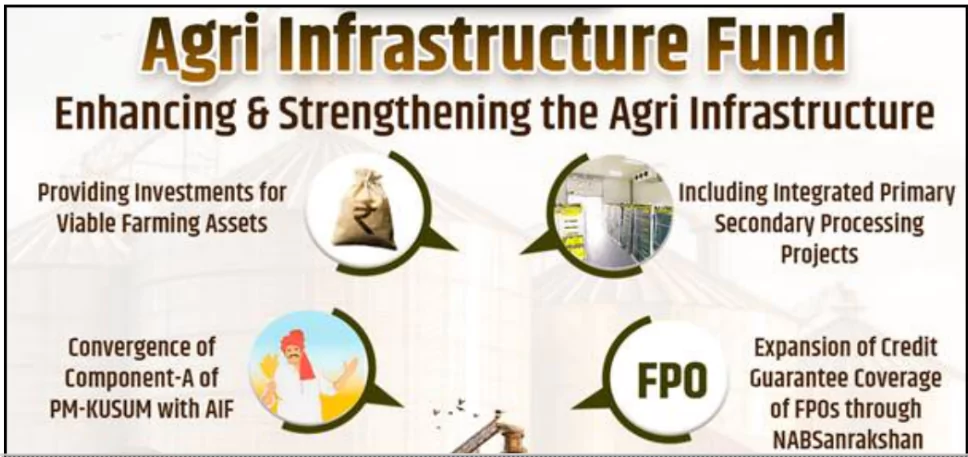The government has expanded the scope of the ₹1 lakh crore Agricultural Infrastructure Fund (AIF) scheme to strengthen farm-related infrastructure in the country.
About Agricultural Infrastructure Fund (AIF) Scheme
- It is a Central Sector Scheme launched in 2020 with an operational period from 2020-21 to 2032-33 focused on Agriculture Infrastructure.
- Objective: Provides medium to long-term financing for post-harvest agricultural infrastructure projects.
 Financial Provisions
Financial Provisions-
- Total Loan Provision: ₹1 lakh crore through lending institutions.
- Interest Rate Cap: 9% on loans.
- Interest Subvention: 3% per annum on loans up to ₹2 crore for 7 years.
- Credit Guarantee: Provided through Credit Guarantee Fund Trust for Micro and Small Enterprises (CGTMSE).
- Project Limits: Private Sector Entities (Farmers, Agri-Entrepreneurs, Startups):
- Can apply for up to 25 projects across different locations.
- Each project is eligible for a ₹2 crore loan.
- Multiple projects at one location allowed within the ₹2 crore cap.
- State Agencies, Cooperatives, FPOs, SHGs: No limit on the number of projects.
- Mandatory Borrower Contribution: Applicants must contribute at least 10% of the total project cost.
Eligible Beneficiaries Under AIF
- Individual Farmers : For on-farm storage and processing units.
- Social Inclusion: 24% of total grants-in-aid must be allocated to SC/ST entrepreneurs.
- Farmer Producer Organizations (FPOs): For community-based infrastructure.
- Self-Help Groups (SHGs) and Joint Liability Groups (JLGs) : Engaged in agriculture-related activities.
- Cooperative Societies and Primary Agricultural Credit Societies (PACS): For collective farming and value addition.
- Startups and Agri-Tech Companies: Developing post-harvest management solutions.
Post-Harvest Management
- Key Practices: Post-harvest management involves crucial steps like handling, grading, curing, ripening, packaging, storage, and transportation to ensure the quality and longevity of agricultural produce.
- Challenges in India: Poor infrastructure and inadequate post-harvest practices lead to significant food losses, amounting to ₹93,000 crores in 2019.
- This affects India’s agricultural exports, placing it 8th among global agri-exporters in 2023.
- Impact on Quality & Marketability: Improper handling results in mechanical (bruising, contamination) and physiological (respiration, pigment changes) losses, reducing market value and consumer acceptance despite government and private sector efforts in post-harvest management.
|
- State Agencies and PPP Projects: For government-backed rural infrastructure projects.
- Entrepreneurs and Agripreneurs: Involved in food processing and value addition.
- Exclusion: Public Sector Undertakings (PSUs) are not eligible, but PPP-sponsored projects are allowed.
Eligible Projects Under AIF
- Post-Harvest Infrastructure
-
- Warehouses, cold storage, silos, drying yards.
- Sorting and packaging units.
- Processing and Value Addition: Food processing plants, oil mills, flour mills, Cashew and kinnow processing units, etc.
- Standalone secondary processing units are not eligible (covered under MoFPI schemes).
- Technology-Driven Solutions: Drone projects and hi-tech farm equipment rental centers.
- Renewable Energy: Solar-powered irrigation and cold storage units.
- Integration with Other Schemes: PM KUSUM Component-A can now be integrated with AIF.
Implementation Status of AIF
- Top Performing States (As of February 28, 2025): Punjab has successfully utilized 100% of its allocated ₹4,713 crore and now ranks No.1 in India for AIF implementation.
| Rank |
State |
Number of Projects |
| 1 |
Punjab |
21,740 |
| 2 |
Madhya Pradesh |
12,487 |
| 3 |
Maharashtra |
10,407 |
| 4 |
Uttar Pradesh |
8,539 |
| 5 |
Tamil Nadu |
7,598 |
- Impact of AIF Implementation: 71% of beneficiaries are farmers.
- 67% of all sanctioned projects cost below ₹25 lakh, ensuring grassroots penetration.
The Agricultural Infrastructure Fund (AIF) scheme has played a crucial role in reducing post-harvest losses, improving farm infrastructure, and enhancing value addition. With the recent expansion of funds the scheme is set to further boost rural employment, agripreneurship, and agricultural modernization across India.
![]() 7 Mar 2025
7 Mar 2025

 Financial Provisions
Financial Provisions